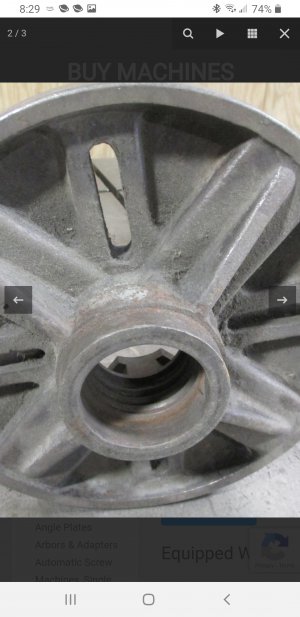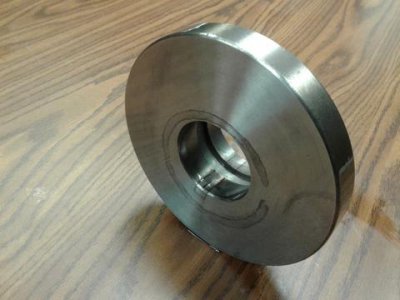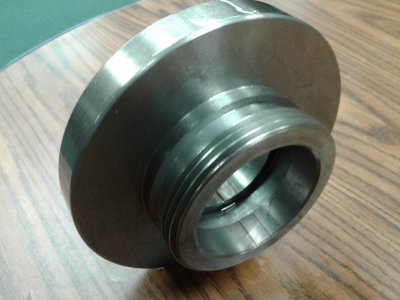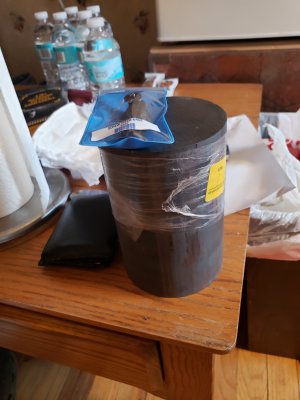-
Welcome back Guest! Did you know you can mentor other members here at H-M? If not, please check out our Relaunch of Hobby Machinist Mentoring Program!
You are using an out of date browser. It may not display this or other websites correctly.
You should upgrade or use an alternative browser.
You should upgrade or use an alternative browser.
What do you guy's think of this faceplate for $125?
- Thread starter Shootymacshootface
- Start date
- Joined
- Mar 17, 2018
- Messages
- 1,400
Update, I emailed the gentleman that I got this plate from. I thanked him for being so generous and told him that when this virus stuff settles down, I will be in to talk to him about finding me a cnc mill that will fit in my garage. I also told him that I would have something nice for his desk. I think that he appreciated my gesture and that I didn't just disappear.
So, here is the back of the plate.

I was thinking of buying a 4" × 6" piece of cast iron and turning one end to fit the plate and cutting my L00 taper on the other end. Then I realized that I would have an attachment that could spin off if run in reverse. Locktite might fix that, but not the best solution.
My other option is to machine the back flat enough to bolt this on.


I haven't figured out which option would have less stickout, but I this there wont be much difference either way .
The cost of the backplate to my door is $71.
The cost of the 4" × 6" cast iron rod is about $58 without shipping from Mcmaster.
So, here is the back of the plate.

I was thinking of buying a 4" × 6" piece of cast iron and turning one end to fit the plate and cutting my L00 taper on the other end. Then I realized that I would have an attachment that could spin off if run in reverse. Locktite might fix that, but not the best solution.
My other option is to machine the back flat enough to bolt this on.


I haven't figured out which option would have less stickout, but I this there wont be much difference either way .
The cost of the backplate to my door is $71.
The cost of the 4" × 6" cast iron rod is about $58 without shipping from Mcmaster.
- Joined
- Aug 3, 2017
- Messages
- 2,437
That backplate looks like it would block the attachment holes, which is about 90% the benefit of a back plate You could always green loctite +pin it, and it would never unscrew!
You could always green loctite +pin it, and it would never unscrew!
- Joined
- Mar 17, 2018
- Messages
- 1,400
I took a good look at the face plate today. I don't think that attaching the L00 backplate is the way to go. ErichKeane is right about blocking any attaching points. My plan was to countersink some flathead bolts from the front in the thickest areas, but after milling the back flat enough to attach a backplate, I would lose too much rigidity and there would be no do over.
So, back to my original plan. It is to buy a 4" × 6" rod.
I guess that cast iron is the right material for this, but I'm not 100% sure.
Could you guys share your thoughts on a material to use for this? It should be a fun project. This Old Tony has a great vid on this very topic. I need to watch it again to learn some of the details.
Thanks.
So, back to my original plan. It is to buy a 4" × 6" rod.
I guess that cast iron is the right material for this, but I'm not 100% sure.
Could you guys share your thoughts on a material to use for this? It should be a fun project. This Old Tony has a great vid on this very topic. I need to watch it again to learn some of the details.
Thanks.
- Joined
- Aug 3, 2017
- Messages
- 2,437
You need a material that doesn't pick up harmonics very well (so as to not make chatter worse), which is why people typically use cast iron.
The This-Old-Tony video is great! Only warning, he uses a shaper to get the keyway. I considered making a backing plate a number of times (since I'm L1, everything is absurdly expensive :/), but could never convince myself that the odd angles on the keyway were worth trying it out.
The This-Old-Tony video is great! Only warning, he uses a shaper to get the keyway. I considered making a backing plate a number of times (since I'm L1, everything is absurdly expensive :/), but could never convince myself that the odd angles on the keyway were worth trying it out.
- Joined
- Mar 17, 2018
- Messages
- 1,400
I was looking at one of my CME backplates, the keyway on those are edm cut and they do not follow the taper. They look straight cut, in line with the tailstock. I might get my first try at cutting a keyway with the tailstock. I wouldn't have to worry about blowing out the back of the slot because I could have a shoulder there to cut against. The straight threaded end that goes into the faceplate only needs a through hole large enough to have access to the taper in the spindle nose for a dead center.
Just thinking outloud.
Just thinking outloud.
- Joined
- Mar 17, 2018
- Messages
- 1,400
- Joined
- Aug 3, 2017
- Messages
- 2,437
"Some Assembly Required".


